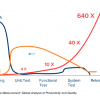 |
Shifting Right Offers New Possibilities for Agile and DevOps Teams The shift-right concept originates from testing. But agile and DevOps teams also can use it to improve their systems and service to the client. However, there is a complicating factor: Different people have different explanations for what shifting right is. Let’s look at the different forms of shifting right, what the potential benefits are, and who should ideally be involved in your shift-right process.
|
|
 |
Simplify Continuous Operation Tests with a Periodic Reboot Continuous operation tests find important bugs, partly as a result of their long operation and partly by increasing the probability of finding statistical bugs. However, CO tests have their own downsides. Mandating a periodic reset or reboot can work around these issues, as well as save time and cost for testing, reproduction, debugging, and fix verification.
|
|
 |
Shifting Your Testing: When to Switch Gears Shifting your testing either left or right can meet different needs and improve different aspects. How do you know whether to make a change? Let your test cycles be your guide. Just like when driving a car with a manual transmission, if the engine starts to whine or you’re afraid you’re about to stall out, switching gears may be just what you need.
|
|
 |
5 Key Factors to Achieve Agile Testing in DevOps Part of the path to DevOps requires adoption of agile methodologies. What does it mean for testing when you switch from the traditional waterfall model, with a few long release cycles per year, to the agile model, with changes occurring every two weeks? Here are five key factors to achieve the agile software testing necessary in DevOps.
|
|
 |
The Shift-Left Approach to Software Testing The earlier you find out about problems in your code, the less impact they have and the less it costs to remediate them. Therefore, it's helpful to move testing activities earlier in the software development lifecycle—shifting it left in the process timeline. This article explores the shift-left methodology and how you can approach shifting left in your organization.
|
|
 |
Testing a Software Rewrite Suppose we’re looking at a system rewrite where the stakeholders have none of the original engineering documentation. (This isn't surprising; documentation becomes obsolete—or even misleading—as the system changes, and corresponding docs don't get updated.) What can we do? Here are some tactics to use—and risks to anticipate—when testing a system rewrite.
|
|
 |
Why You Need Continuous Testing in DevOps DevOps is more than adopting the right set of tools; it's a cultural shift that incorporates testing at each stage of the agile project lifecycle. Continuous testing is key to unlocking this culture change because it weaves testing activities into every part of the software design, development, and deployment processes, which helps everyone involved communicate more, collaborate better, and innovate faster.
|
|
 |
Shifting Testing Left Bakes In Quality from the Start “Shift left” is one of the latest buzz terms in software testing. Movements like agile and DevOps recommend that testers shift left, but what does that mean, exactly? Here's how one tester became a believer in the shift-left movement; how he got his team's developers, analysts, designers, and managers on board; and how his entire organization has benefited from the shift.
|
|
 |
5 Ways to Optimize Tests for Continuous Integration Many teams have existing automated test suites that are not included in a continuous integration program. Maybe the tests take too long to execute, or they are not reliable enough to give accurate results. Here’s how to assess your test suites in terms of value added and time to execute, along with five proven strategies to optimize those suites for CI.
|
|
 |
Shifting Testing Left Is a Team Effort There is a lot of talk in the testing world about shifting left. Basically, “shift left” refers to moving the test process to an earlier point in the development process, independent of the development approach. This article explores a case in which shift-left has been applied, and the lesson is that shifting left cannot be achieved by testers alone—it must result from a team effort.
|
|

